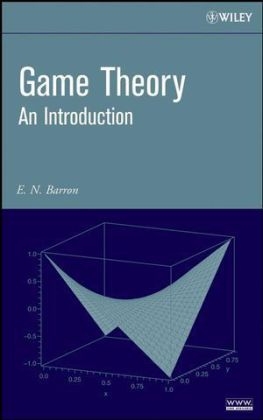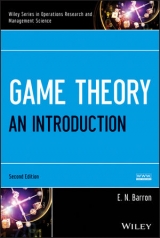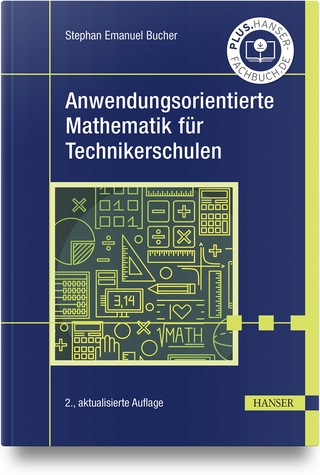
Game Theory
Wiley-Blackwell (Verlag)
978-0-470-17132-5 (ISBN)
- Titel ist leider vergriffen;
keine Neuauflage - Artikel merken
A fundamental introduction to modern game theory from a mathematical viewpoint Game theory arises in almost every fact of human and inhuman interaction since oftentimes during these communications objectives are opposed or cooperation is viewed as an option. From economics and finance to biology and computer science, researchers and practitioners are often put in complex decision-making scenarios, whether they are interacting with each other or working with evolving technology and artificial intelligence. Acknowledging the role of mathematics in making logical and advantageous decisions, Game Theory: An Introduction uses modern software applications to create, analyze, and implement effective decision-making models. While most books on modern game theory are either too abstract or too applied, this book provides a balanced treatment of the subject that is both conceptual and hands-on. Game Theory introduces readers to the basic theories behind games and presents real-world examples from various fields of study such as economics, political science, military science, finance, biological science as well as general game playing.
A unique feature of this book is the use of Maple to find the values and strategies of games, and in addition, it aids in the implementation of algorithms for the solution or visualization of game concepts. Maple is also utilized to facilitate a visual learning environment of game theory and acts as the primary tool for the calculation of complex non-cooperative and cooperative games. Important game theory topics are presented within the following five main areas of coverage:* Two-person zero sum matrix games* Nonzero sum games and the reduction to nonlinear programming* Cooperative games, including discussion of both the Nucleolus concept and the Shapley value* Bargaining, including threat strategies* Evolutionary stable strategies and population games Although some mathematical competence is assumed, appendices are provided to act as a refresher of the basic concepts of linear algebra, probability, and statistics. Exercises are included at the end of each section along with algorithms for the solution of the games to help readers master the presented information.
Also, explicit Maple and Mathematica(r) commands are included in the book and are available as worksheets via the book's related Web site. The use of this software allows readers to solve many more advanced and interesting games without spending time on the theory of linear and nonlinear programming or performing other complex calculations. With extensive examples illustrating game theory's wide range of relevance, this classroom-tested book is ideal for game theory courses in mathematics, engineering, operations research, computer science, and economics at the upper-undergraduate level. It is also an ideal companion for anyone who is interested in the applications of game theory.
E. N. Barron, PhD, is Professor of Mathematical Sciences in the Department of Mathematics and Statistics at Loyola University Chicago. He is the author of over fifty research journal articles, and his teaching experience includes optimal control, stochastic processes, differential games, analysis, operations research, game theory, and financial mathematics, among others.
Preface. Acknowledgments. Introduction. 1. Matrix 2 person games. 1.1 The Basics. Problems. 1.2 The von Neumann Minimax Theorem. Problems. 1.3 Mixed strategies. 1.3.1 Dominated Strategies. 1.4 Solving 2 x 2 games graphically. Problems. 1.5 Graphical solution of 2 x m and n x 2 games. Problems. 1.6 Best Response Strategies. Problems. 2. Solution Methods for Matrix Games. 2.1 Solution of some special games. 2.1.1 2 x 2 games again. Problems. 2.2 Invertible matrix games. Problems. 2.3 Symmetric games. Problems. 2.4 Matrix games and linear programming. 2.4.1 A direct formulation without transforming. Problems. 2.5 Linear Programming and the Simplex Method (Optional). 2.5.1 The Simplex Method Step by Step. Problems. 2.6 A Game Theory Model of Economic Growth (Optional). Problems. 3. Two Person Nonzero Sum Games. 3.1 The Basics. Problems. 3.2 2 x 2 Bimatrix Games. Problems. 3.3 Interior Mixed Nash Points by Calculus. Problems. 3.3.1 Proof that there is a Nash Equilibrium for Bimatrix Games (Optional). 3.4 Nonlinear Programming Method for Nonzero Sum 2 person Games. Problems. 3.5 Choosing among several Nash Equilibria (Optional). Problems. 4. N Person Nonzero Sum Games with a Continuum of Strategies. 4.1 The Basics. 4.2 Economics applications of Nash equilibria. Problems. 4.2.1 Duels. Problems. 4.3 Auctions (Optional). 4.3.1 Complete Information 208. Problems. 4.3.2 Incomplete Information. 4.3.3 Symmetric Independent Private Value Auctions. Problems. 4.3.4 Symmetric Individual private value auctions again. Problems. 5. Cooperative games. 5.1 Coalitions and Characteristic Functions. Problems. 5.1.1 Finding the least core. Problems. 5.2 The Nucleolus. Problems. 5.3 The Shapley Value. Problems. 5.4 Bargaining. 5.4.1 The Nash model with security point. 5.4.2 Threats. Problems. 6. Evolutionary Stable Strategies and Population games. 6.1 Evolution. Problems. 6.2 Population games. Problems. Appendix A: The essentials of matrix analysis. Appendix B: The essentials of probability. B.0.1 Order Statistics. Appendix C: The Essentials of Maple. Appendix D: The Mathematica commands. Appendix E: Biographies. Appendix F: Solutions to selected Problems. Problem Solutions. References. Index.
| Erscheint lt. Verlag | 1.2.2008 |
|---|---|
| Zusatzinfo | Illustrations |
| Verlagsort | Hoboken |
| Sprache | englisch |
| Maße | 158 x 241 mm |
| Gewicht | 708 g |
| Einbandart | gebunden |
| Themenwelt | Mathematik / Informatik ► Mathematik ► Angewandte Mathematik |
| Mathematik / Informatik ► Mathematik ► Finanz- / Wirtschaftsmathematik | |
| ISBN-10 | 0-470-17132-4 / 0470171324 |
| ISBN-13 | 978-0-470-17132-5 / 9780470171325 |
| Zustand | Neuware |
| Haben Sie eine Frage zum Produkt? |
aus dem Bereich



